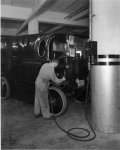YouWOULD hope that's the case...
It all sounds easy and sensible on paper. But I've been in the vehicle service world for a long, long, time. I guarantee you, you're overestimating the logic they apply. I encourage the attempts, but I see major design/serviceability flaws far more often than you'd think from every manufacturer. I've seen the last 5 "finalists" for the postal fleet replacement. I was not surprised that every one of them failed to survive their first 6 month "on the job" testing run. (BTW, Workhorse, a company mentioned in the OP's news article, was also one of those finalists. It was all electric too.) Optimism is great. And like I said, I'm all for progress. But I'm also one of those "boots on the ground" and have lived to see what works in that real environment.
Think about it this way...
"Is it ever wise to buy the first year of a brand new model?"
Most savvy car buyers know there'll be teething pains and recalls, because EVERY manufacturer basically sends out beta versions to the public. Well this is the same thing, but with extreme use and a ton of money on the line.
Another thing for me is the charging. The article mentions they'll tap into the 500 charge points they have across the state. 500 in the whole state? I have one station alone in San Jose Ca with 110 LLV's. My total local area fleet has 2100 vehicles, and we're just covering Santa Clara and Monterey county. There's going to need to be some serious infrastructure upgrades to the post offices to handle the charging.
RDinNHand,
Most current/older generation delivery vehicles don't have AC. The USPS' main mail delivery vehicle is the GM based/ Grumman bodied LLV. Every one of them was built before 1994. VERY few of them have AC, and from what I've heard, the ones that do had it added in later. Back in the mid 80's/early 90's, air conditioning was still an optional, and fairly expensive option, for most vehicles. So VERY few of our fleet vehicles ever had AC. These days AC is a standard feature on practically every passenger vehicle, as well as most medium and heavy trucks. Some of that is because of the emissions verification process, where each engine package gets certified complete with all accessories. And having to develop different configurations is less cost effective with each generation. Our last generation Big Rig tractors, and our newest generations of 11-tons and 2-tons came with AC. There have also been some driver health problems that have arisen because of the lack of AC, including at least one recent death, so all the involved parties (unions) have been deciding if it's going to be an absolute requirement in the future.
So I've made my statements in this thread going with the assumption that all future vehicles will be required to have AC. But as of this moment, for our fleet, it's not required in the labor contract yet.
"Do you need AC/ heat in every market?"
Not at all. But I when you're buying a fleet, you have to assume your vehicles may be reallocated to different areas as needs change. So you typically buy one configuration that "fits all". My facility in the SF Bay Area got a new fleet of 11-ton box trucks for local use. Just like all the other areas that got trucks from this buy, ours came equipped with retractable snow chains. Completely useless in my area. But if they ever relocate to another area, they may be necessary.
(Honestly, as a fleet mechanic, AC is a royal pain. Again, the extreme use just seems to cause more faults. But like smog techs, AC techs need to be certified. Don't have a certified tech on staff? By law you now need to contract it out. Plus the machine and the refrigerant are added costs. And when it's hot, the drivers never think it's cooling enough, even when it's in spec because most cargo vehicles have little or no insulation. So now there's a vehicle out of service for the day, or more, while you chase a non existent problem. Etc. etc.)




